Petra, Jordan March 28 & 29
To get to Al Aquabah from Oman we traveled along the coast of Yemen, then through the Straits of Aquaba
with Djibouti on one side and Yemen on the other. I snapped the picture below of the Yemen shore.

Jordan is semi-arid, and except for a small outlet on the Red Sea is land locked. It was this small portion, Al Aquabah, (Can be spelled with or without the final “h,” and with or without the “al” which means the.) where we docked.
Brief (very) overview of history of Jordan from Wikipedia.
Jordan, officially The Hashemite Kingdom of Jordan, has been inhabited by humans since the Paleolithic period. Three stable kingdoms emerged there at the end of the Bronze Age: Ammon, Moab and Edom, all Biblical tribes. Later rulers include the Nabataean Kingdom, the Roman Empire, and the Ottoman Empire. After the Great Arab Revolt against the Ottomans in 1916 during World War I, the Ottoman Empire was partitioned by Britain and France. The Emirate of Transjordan was established in 1921 by the then Emir Abdullah I and became a British protectorate. In 1946, Jordan became an independent state officially known as The Hashemite Kingdom of Transjordan.
Jordan captured the West Bank during the 1948 Arab–Israeli War and in 1949 the name of the state was changed to The Hashemite Kingdom of Jordan. It lost the West Bank to Israel in 1967. Jordan is a founding member of the Arab League and the Organization of Islamic Cooperation, and is one of two Arab states to have signed a peace treaty with Israel. The country is a constitutional monarchy, but the king holds wide executive and legislative powers.
The plan at the start of the Jordan tour was to spend day 1 (March 28) visiting Wadi Rum, then spend the night in Wadi Moussa near the entrance to Petra to get an early start in visiting this UNSESCO World Heritage Site. After driving from Wadi Rum, having our new lecturer fall and have to be taken to the hospital, as we were about to descend to our hotel, we received word that the hotel was on strike and we could not stay there. Plus, with 3 cruise ships in port, there were no other rooms available. So… we had to traipse the 2 hours back to our ship. Thank-heavens we had that place to stay.
Wadi Rum
Wadi Rum is a geological entity. Like much of the rest of the Jordan River Valley the rock formations have streaks of different colors denoting various mineral deposits. Unfortunately, they are not in a usable condition and the only mineral they mine is phosphate and that is all exported for refining.
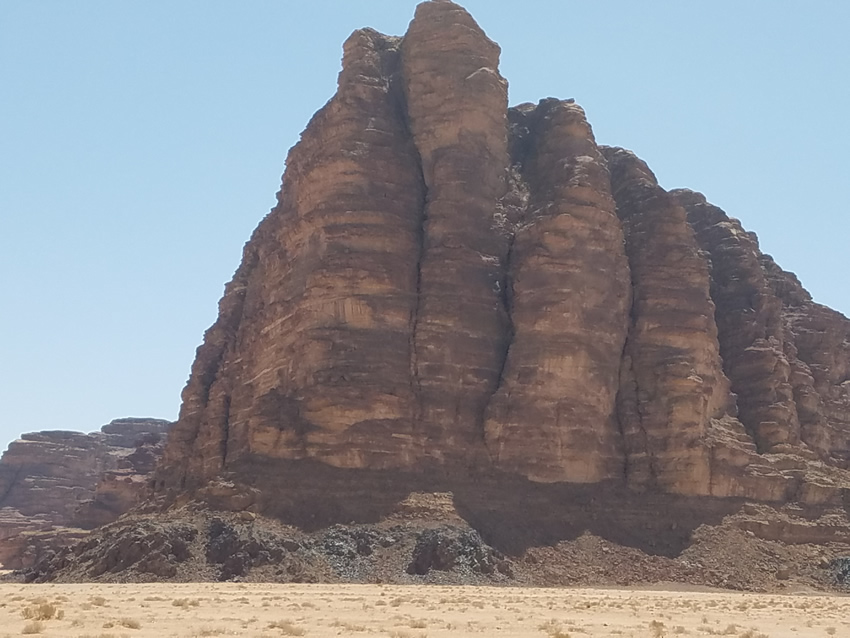
This formation is known as the 7 pillars
Wadi Rum's resemblance to what we envision the surface of Mars to be has made it a popular filming and tourist attraction, including scenes in The Martian. It is impossible to describe it, one needs to experience it.
To explore this area we rode in the back of 4x4 Toyota pickups. After an hour of some stops and marveling at the sites we stopped for tea in a Bedouin tent. They made tea just for us, and it was about half as sweet as they drink it. They start with black tea and add spices, cardomon, and I think sage and other spices then add lots of sugar. Even made for us it was to out taste, very sweet – but great! It was a nice break in bouncing over the sands, sometimes flying down dunes, others working our way up them. Lunch was in another Bedouin tent and was a buffet at which, as usual, there was way more food than one could experiment with tasting.
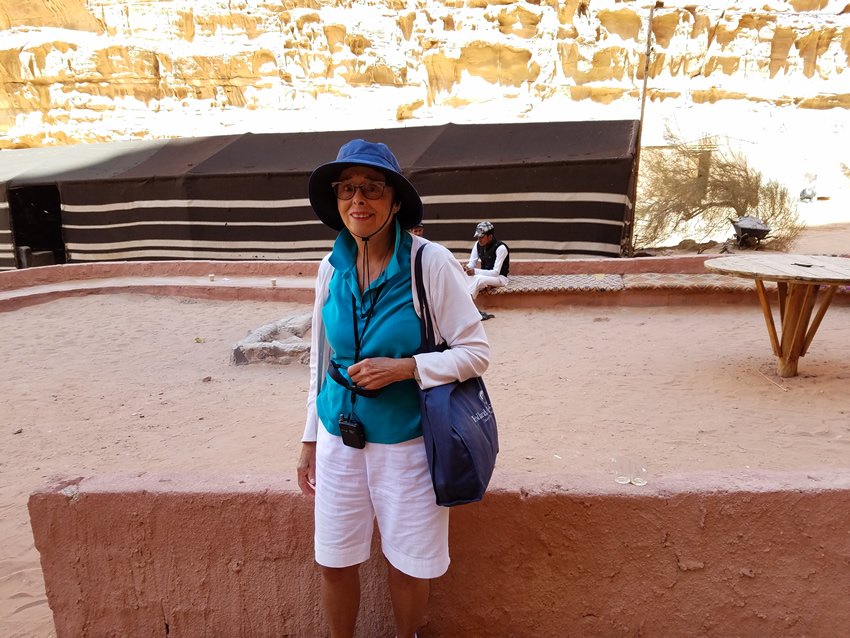
The tent in the background is really much bigger! In fact it was huge and had carpteted floors like all Bedouin tents.
In some of our stop-overs there were camels available to ride. We also saw a baby camel, about 2 months old. Camels make the most obnoxious sounds, sort of like a very hoarse, and insistent moo. Another camel fact, they are more docile in summer, because rutting season is over.
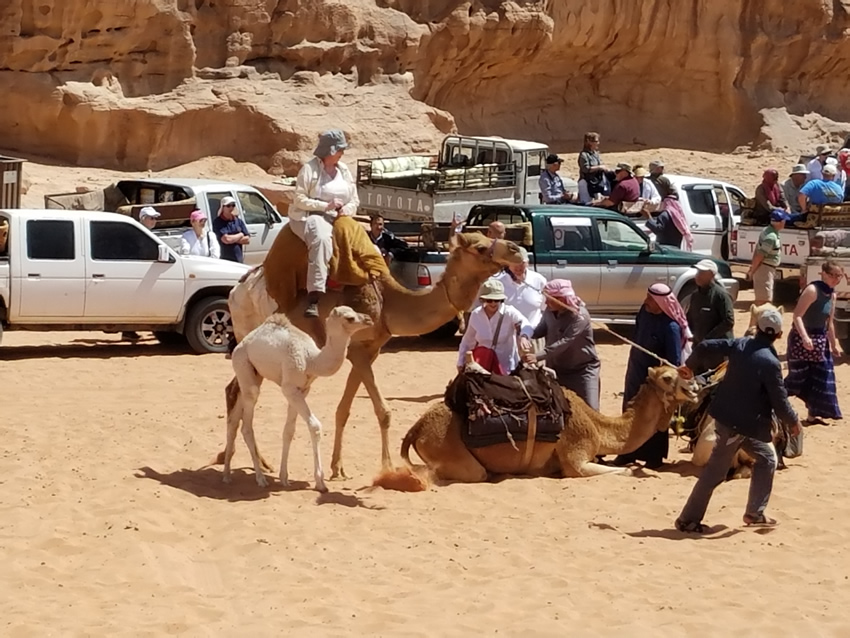
During the years of the Silk Route, the camel caravans and Bedouins traversed this area. These many rock formations sometimes had a passage through them and sometimes did not. One of the factors that the Bedouins used to determine whether they could get through was to shout and see if it echoed. Presumably they could distinguish the different echo sounds and make their decision based on that.
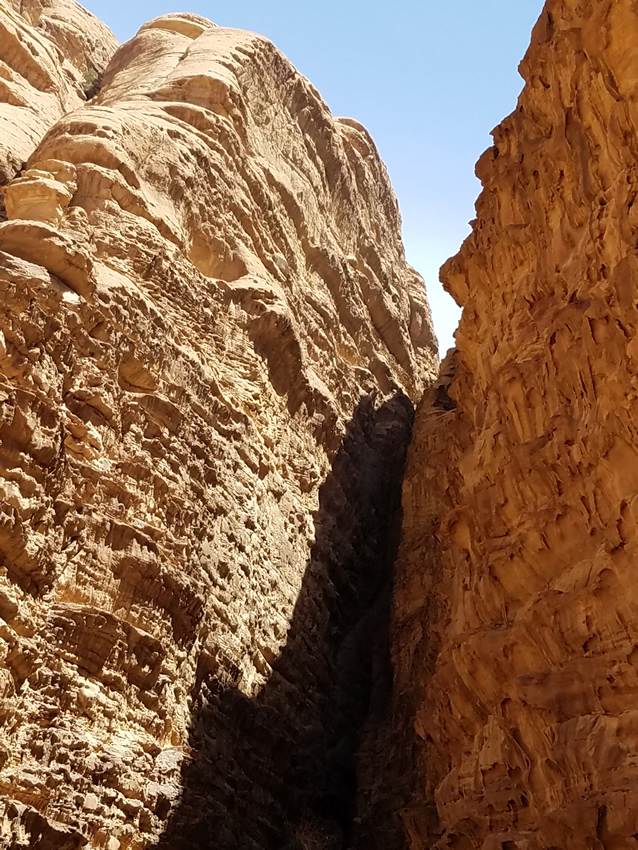
Our guide was a Bedouin, but a modern one with a Master's Degree, but also pround to be a Bedouin. Tribes are still very important here. The tribe head, called a sheik settles many small disagreements in the tribe. It is completely non-governmental, and the Bedouins always have access to governmental courts, but seldom use them. The tribes also get along with one another and there are no rules about marrying within a tribe. Our unmarried guide's mother wants him to marry so desperately that she told him, "I don't care if the girl is from the moon, just get married."
The guide described Jordan as one big family. In his "limited" family, he has 7 uncles, and 24 first cousins and too many to count second cousins. However, the modern family is usually only 2 or 3 children and the children marry late.
Unfortunately, the country of Jordan is a poor family; they have no oil. Although the king is now Abdullah II, Queen Nor who was the second wife of King Hussein ll, is still very well regarded. She did a lot for Jordan, liberating women, getting permission for them to drive and work and providing education for them. She is not the mother of the current King, he was the son of the first wife. The Queen is still very active in Jordan and divides her time between there and the U.S. You may remember that she is the daughter of Najeeb Hallaby, who was President of Pan Am.
There are nomadic Bedouins today, with camels, sheep, and goats. On our travels we passed many Bedouin tents which are rectangular. Inside there are always Persian carpets on the floor. There are also sheep tended by a shepherd dressed as they have been for thousands of years, like we see them in Christmas pageants.
Interestingly the border with Saudi Arabia is sort of open to the Bedouins whose camels may not respect the border and drift into Saudi. Here living has not changed much in 5000 years with a few modern exceptions; they now have cell phones. When they notice some of their camels have gone over the border, they call other Bedouins in Saudi and ask them to send them back, which they do.
The Bedouins have a very strong code of ethics and are very hospitable. It you come to their door, they consider it an honor to have you visit their tent and will serve you the very best. Many of the nomadic Bedouins have Toyota 4x4 pickups trucks for use along with their camels when they move. Camels are still the “ship of the desert” and can go 7 days without water, but then can drink 45 liters at once.
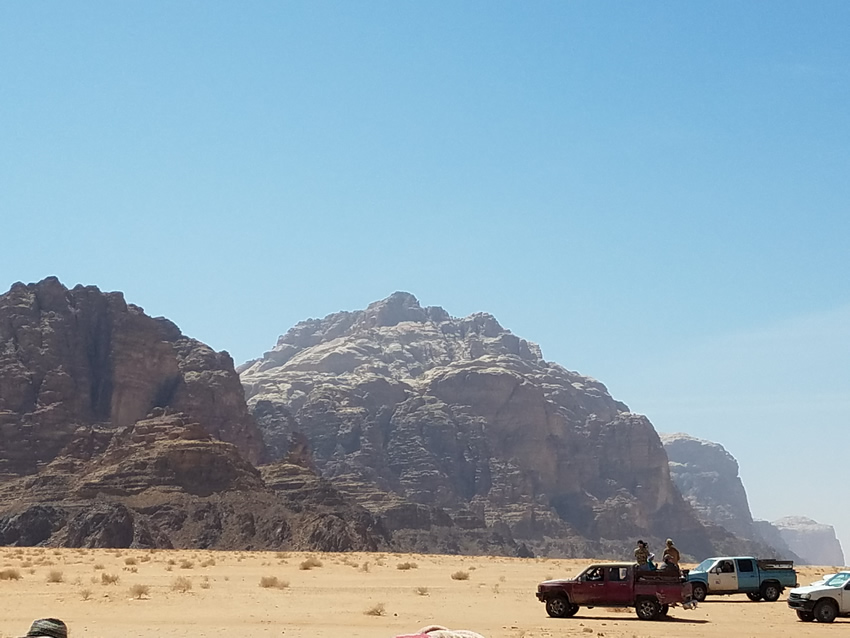
I can't capture the desolateness together with the magnifcent rock formations in any of these pictures. It is truly breathtaking and amazing.
Petra
Petra has been called the Rose City because of the color of the stone from which it is carved. It was described as "a rose-red city half as old as time" in a Newdigate Prize-winning poem by John William Burgon, who had never been there. UNESCO has described it as "one of the most precious cultural properties of man's cultural heritage". It was named amongst the New 7 Wonders of the World in 2007 and was also chosen by the Smithsonian Magazine as one of the "28 Places to See Before You Die.”
Established possibly as early as 312 BC as the capital city of the Arab Nabataeans, Petra is Jordan's most-visited tourist attraction. The Nabateans were nomadic Arabs who benefited from the proximity of Petra to the regional trade routes. They made it into a major trading hub, enabling them to gather wealth. The Nabateans had the knowledge to build efficient water collecting methods in the barren deserts. Below is a picture of part of one.
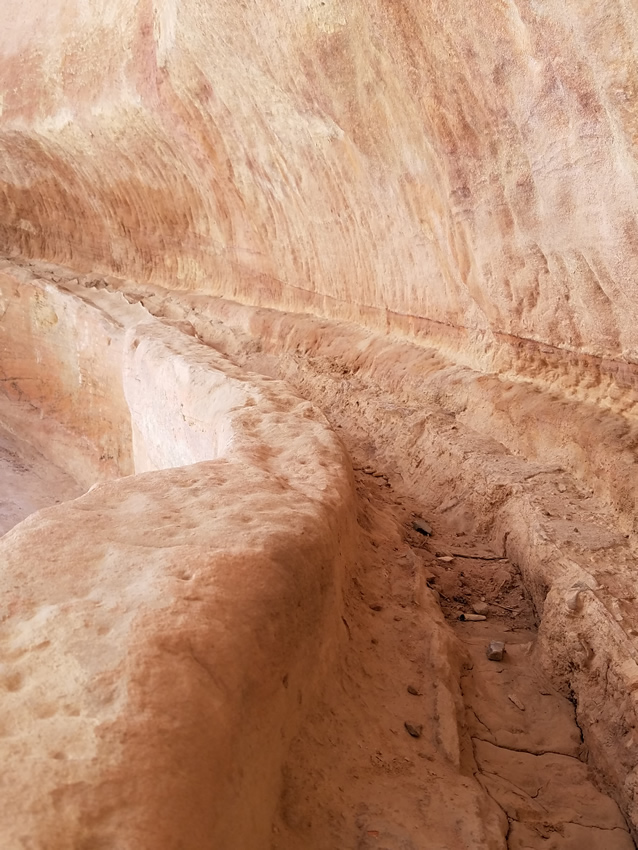
Petrar lies on the slope of Jebel al-Madhbah (identified by some as the biblical Mount Hor. It is among mountains which form the eastern flank of Arabah (Wadi Araba), the large valley running from the Dead Sea to the Gulf of Aqaba.
Petra fell to the Roman Empire in 106 AD and its downfall was completed in 363 AD by an earthquake that destroyed its extensive water collecting and distributing system. Although the Bedouins knew of its existence, it was hidden to the rest of the world until 1812 when it was introduced by Swiss explorer Johann Ludwig Burckhardt. He had heard of the lost city and ingratiated himself to the Bedouins by converting to Islam, becoming very friendly with them, and eventually convincing them to show it to him. As I write only about 25% of it has been excavated. Presently there are not funds to continue this work.
Most of you have seen pictures of the so-called Treasury, which actually was a burial chamber. Originally there was a vessel on top, which was broken by potential looters who thought it contained coins, thus the name Treasury. The photo below is one of your first views of the "Treasury" as you approach through the end of the Siq, or the "gorge" through which you pass to see Petra.
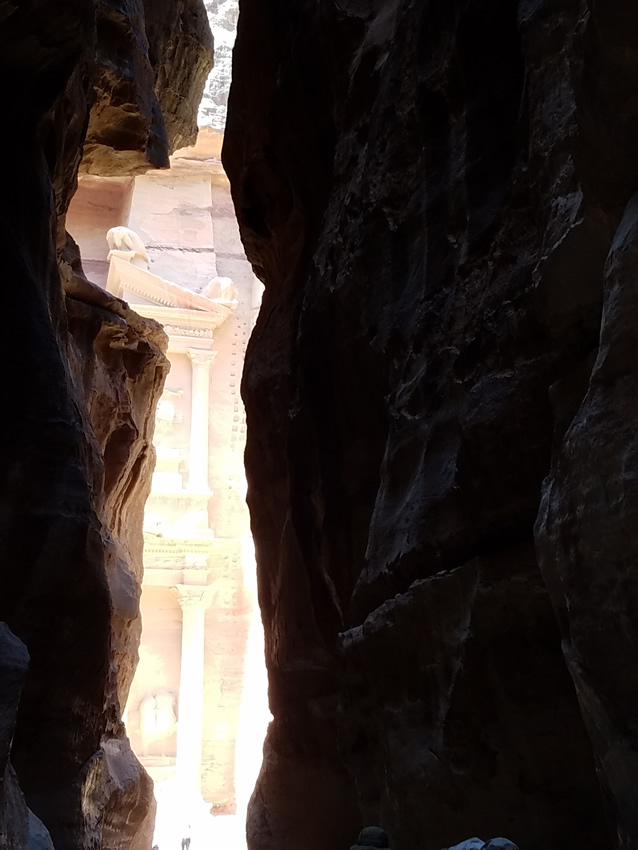
A little farther from the Treasury, at the foot of the mountain called en-Nejr, is a massive theatre, positioned so as to bring the greatest number of tombs within view. At the point where the valley opens out into the plain, the site of the city is revealed with striking effect. The amphitheatre has been cut into the hillside and rectangular gaps in the seating are still visible.
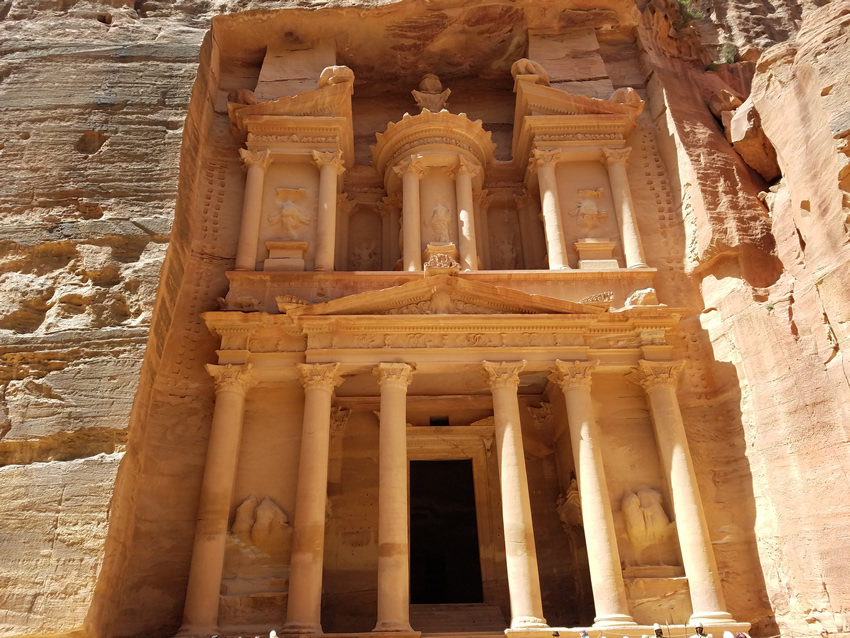
Above is the so called Treasury.
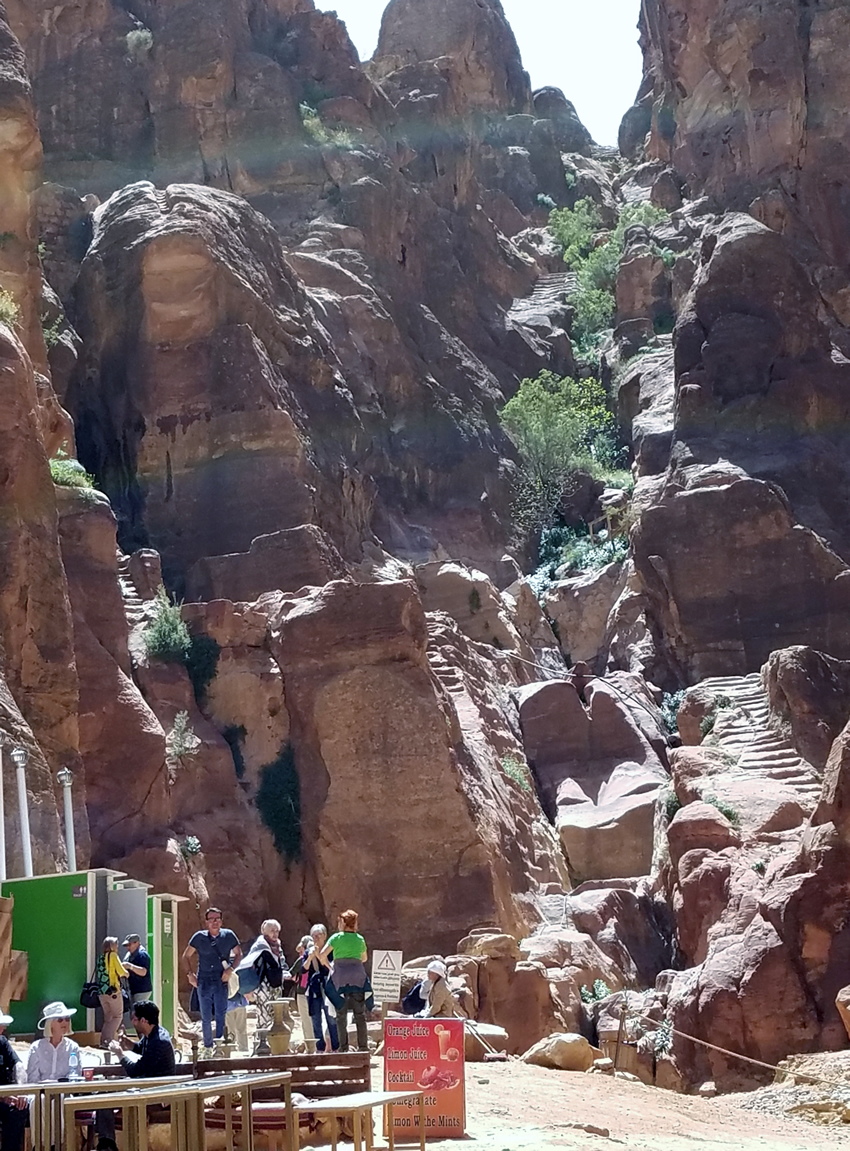
One of the sights at the Treasury.
Because we wanted to get to Petra early to avoid the worst of the crowds, we left the ship before 7 and were there before 9a. There were still many people there. The gate to all these mavels is through the Siq, a narrow passage through rocks. Not only people on foot, but the carriages carrying those who can’t walk come through here, often at breakneck speed with their passengers holding on for dear life as they are bounced along. It is a shame to hurry though this portion because it is so captivating.

With my bum hip, I only walked the mile and a quarter downhill to the Treasury and then was lucky enough to get away from the group and dilly dally my way back up to the gate through the Siq. The Siq, to me was the best feature.… I had time to converse with a young Muslim woman who had her two children with her and wanted to practice her English. There were many Muslim visitors, some from Jordan, others from other countries. Most of the time I found that the young girls were very friendly and wanted to wave and say hello, whereas the woman, for the most part, avoided my eyes. Still, there were exceptions and that was rewarding.
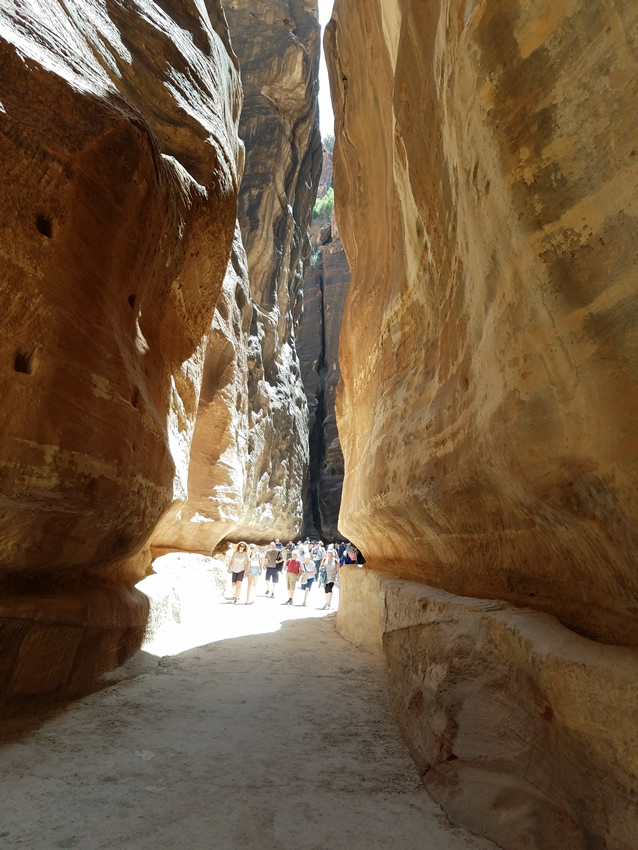
Petra is definitely a must see if you get a chance as is Wadi Rum. Much of the scenerygetting there is also breathtaking. The mountains are dry – making it look very desolate. Tourism is the main stay of the Jordan Valley, and that goes up and down with world events as well as the economy. People are afraid to visit the Middle East, but we felt perfectly safe there. Our "pirate fend off barbed wire" was removed while we were there.
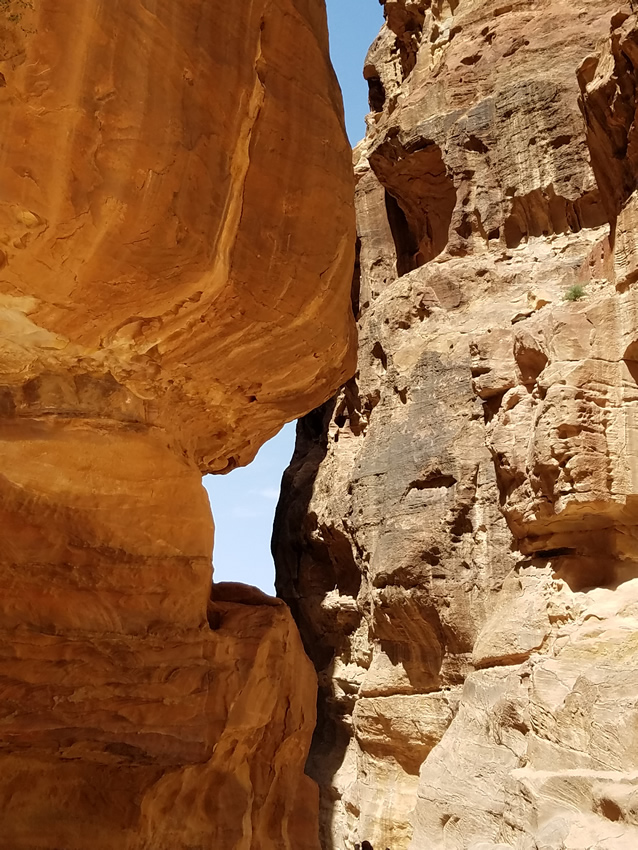
Another view of the Siq. I regret not being able to go any farther. We were extremely lucky with the weather, it was in the low 70s with a breeze. The end of March or early April are ideal to visit both of these places.
